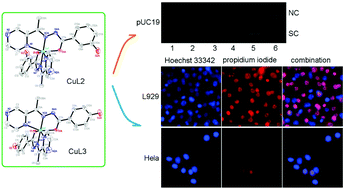Copper(ii) complexes with NNO ligands: synthesis, crystal structures, DNA cleavage, and anticancer activities†
Abstract
Three novel copper(II) complexes, Cu(L1)2 (1), Cu(L2)2·2DMF (2), and Cu(L3)2·2DMF (3), were synthesized using three aroylhydrazone ligands, (E)-2-hydroxy-N′-(1-(pyrazin-2-yl)ethylidene)benzohydrazide (HL1), (E)-3-hydroxy-N′-(1-(pyrazin-2-yl)ethylidene)benzohydrazide (HL2) and (E)-4-hydroxy-N′-(1-(pyrazin-2-yl)ethylidene)benzohydrazide (HL3). The complexes were characterized by elemental analysis, infrared (IR), and Ultraviolet-visible light (UV-vis) spectroscopy. The X-ray crystal structures of the complexes all possess a distorted octahedral coordination geometry. Both an absorption spectral titration and a competitive binding assay (ethidium bromide, 4′,6-diamidino-2-phenylindole (DAPI), and methyl green) revealed that complexes 2 and 3 bind readily to calf thymus DNA (ctDNA) through intercalative and minor groove binding modes. Complexes 2 and 3 also exhibited oxidative cleavage of supercoiled plasmid DNA (pUC19) in the presence of ascorbic acid as an activator. Cytotoxicity studies showed that complexes 2 and 3 possessed high cytotoxicities toward the HeLa human cervical cancer cell line, but weak toxicities toward the L929 normal mouse fibroblast cell line. We therefore have reason to believe that complexes 2 and 3 both show potential as promising anticancer candidate drugs.



 Please wait while we load your content...
Please wait while we load your content...